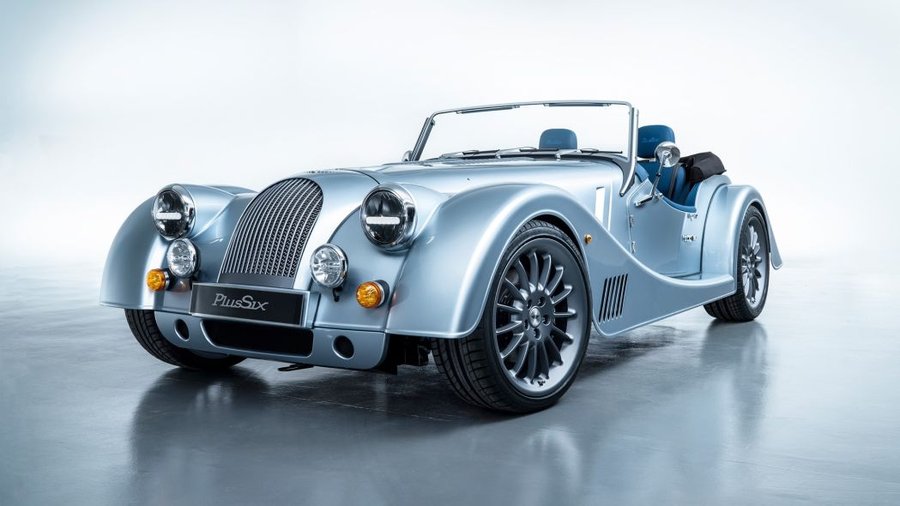How Morgan is putting its newest anachronistic roadster together

It happens, on average, just once in every 27 years. There are comets that appear more regularly than a new Morgan chassis. In 110 years of existence there have only ever been four all-new ones from this archetypal British sports car maker nestled in the Malvern Hills. In recognition of this fact, they've called it the CX, which the Roman scholars among you will recognize as denoting 110.
And it's fitted with a straight-six engine, once deemed such an impossible feat by Morgan that Morgan inked a deal to put a Rover/Buick 3.5-liter V8 engine in the 1969 Morgan Plus 8 instead. That makes Morgan's new Plus Six model the first straight-six Morgan, as well as the first turbocharged production Morgan.
The new chassis uses extruded aluminum spars, riveted and bonded together like the first Lotus Elise. It is certainly the most modern and technical Morgan ever built, yet in time-honored manner, the hand-crafted body sits on an ash-wood frame just as it did on the earliest three-wheel Morgans produced by the HFS Morgan over 100 years ago.
The engine is BMW's B58, a 335 horsepower, three-liter turbocharged straight six, coupled to the company's version of the ZF eight-speed transmission driving the rear wheels. It's one of the finest sixes in existence and will give the Plus Six a 166 mph top speed, with 0-62 mph time of 4.2 seconds and reduced carbon dioxide emissions. The suspension is a new front double wishbone suspension system with a four-link independent rear, and the car runs on a new design of 19-inch wheel.
It's a darn close fit, though, sitting closer to the frame rails than even the big 4.8-liter naturally aspirated M60 BMW V8 that powered the outgoing Aero and Plus 8 models. John Beech, Morgan's chief engineer, explains that the engine ancillaries have had to be re-machined and remounted to clear the hood, and the exhaust was completely redesigned from a single 88mm-bore manifold pipe into a collector box and exiting via four smaller tailpipes, which allows sufficient rear ground clearance.
"It's been the chance of a lifetime," says Beech. His former job was in manufacturing engineering at Lotus, so he's familiar with the benefits of this form of aluminum construction. "They didn't actually tell me what Peter Morgan said when they offered me the job," he says. "And it has been a lot of work to get this engine in."
"But the cooling system has been the biggest challenge," he says, explaining that the requirement to get cooling air out from the engine bay has meant that the famous louvered Morgan bonnet has received a few extra holes; a couple of nostrils at the front and side vents at the rear.
With just 24 people in engineering and design, it seems hard to believe it's taken the company just three years of development. While the car might look like the outgoing Plus 8, as Jonathan Wells, Morgan's head of design explains, "of the 3,000 or so parts, there's been a carryover of about 1 percent. We've had a new engineering team, new processes, new production methods; this is Morgan looking forward to the next decades."
He says that while the initial car will be known as the Plus Six, there will be an Aero model to follow and eventually other derivatives. "This is the first iteration of this platform," he says, "and we're not ruling anything out."
One of the biggest changes is in the cockpit, a cramped place on previous Morgans, which usually ruled out those of taller stature. While the body is roughly the same size as the outgoing Plus 8 (the front wings are almost carryover), there's 0.79 inches more in the wheelbase and the design and engineering teams have found almost eight inches more legroom, an additional 3.2 inches across the cockpit and a deeper and more useful rear parcel shelf. Pretty much anyone will fit into this new Morgan, and it's comfortable, too, with adjustable steering, air conditioning, and even power locks.
The dashboard is completely redesigned with Morgan's traditional centrally mounted speedo and rev counter, but with modern instruments and a small digital display screen in front of the driver. Unlike Morgans of yore, there's no need to slam things shut; there's an accuracy and precision about this body framing.
"We want people to see it as a marriage of technology and craft," says Morris. "We didn't want them to think of Morgan as a transport museum, we do have advanced technology in there, but wanted to keep the traditions in shape and craft."
Build time, that bugbear of old Morgan models, is about four weeks, half that for the old Plus 8. And the factory can produce about six cars a week, so expect a waiting list. Sadly, though, Americans won't get a chance to own one of these iconoclastic two seaters. The new chassis might be the strongest and stiffest Morgan ever made, but it won't pass America's fearsome pylon test, and nascent new small-volume manufacturer laws, which would allow Morgan to sell its cars, are stuck in U.S. legislative hell.
The Morgan Plus Six goes on sale later this year priced from £89,995 for the fully loaded First Edition car and £77,995 for the base level model. A bit of good news from the British motor industry, then, but sadly not one we're able to share with American enthusiasts.
Verwandte Nachrichten
